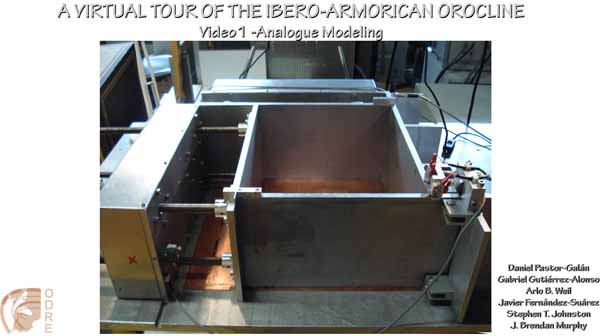Analogue Modelling
Thermo-mechanical analogue modelling provides insight into the feasibility of oroclines being lithospheric. We modelled lithospheric-scale buckling about a vertical-axis of rotation using plasticines with known contrasting rheological properties that were scaled to the mechanical properties of the crust, mantle lithosphere and the sub-lithospheric mantle (Pastor-Galán et al., 2012b). A synthesis of the scaling parameters is shown in Table 1.
Table 1. Scaling parameters used in the modeling experiments
| Lower-crust | Lithospheric-mantle | Asthenosphere | ||
|---|---|---|---|---|
| ρ (kg/m3) | Experiment | 1250 | 1400 | 1250 |
| Nature | 3100 | 3360 | 3100 | |
| Scaling factor | 0.4 | 0.41 | 0.4 | |
| ηeff (Pa·s) | Experiment | 12900 | 57300 | 590 |
| Nature | 1.13x1021 | 5x1021 | 5.15x1019 | |
| Scaling factor | 1.146x10-17 | 1.146x10-17 | 1.146x10-17 | |
| n | Experiment | 7.8 | 4.37 | 3.41 |
| Nature | From 4 to 8 | From 2 to 5 | From 2 to 5 |
The modelling apparatus has a thermo-copper plate connected to an oven capable of imparting a vertical thermal gradient during experimental runs (Video 1). This thermal gradient allowed significant rheological change through time as Ibero-Armorican orocline is inferred to have happened during the formation of the Ibero-Armorican orocline. After buckling, the models were imaged using three-dimensional computer tomography (CT) using a 0.5 mm slice window and 0.5 mm slice depth, which rendered optimal resolution for the plasticines used in the experiments (3D images and Video 1).
The experimental set-up consisted of a 30x12x8 cm elongate model block (crust and lithospheric mantle and its underlying asthenospheric mantle), which was shortened into a buckle fold about a vertical axis (two examples view from a zenith camera shown in Video 1). Multiple experimental set-ups were used with variable strain rates and lithospheric thicknesses. Experimental runs were performed under a constant temperature profile designed to maintain a stable viscosity contrast between the different layers. Model results indicate that, regardless of layer thicknesses used, or the strain rate employed during oroclinal buckling, the mantle lithosphere thickened beneath the orocline core, and thinned around the orocline outer arc. Thinning in the outer arc was accommodated by radial tension fractures, features that have not been observed in Iberia. Thickening in the inner arc was dependent upon initial lithosphere thickness. Thick mantle lithosphere further thickened through the formation of a tight, steeply plunging conical fold, whereas thin mantle-lithosphere thickened through formation of recumbent conical nappes (see 3D representations and Video 1). Although there are differences in detail, the first-order lithospheric-scale processes inferred to have taken place during the generation of the Ibero-Armorican orocline are well reproduced in the analogue experiments.
Virtual reality 3D representations were obtained using Computed Tomography (CT) analysis and show the morphology of the mantle lithosphere within the model. These 3D images were built in .pdf files and require Acrobat 9 or higher to view. Video 1 is a compendium film containing the development as well as the CT results of some of the experiments and the interpretation of the results.
Animation video.

Experimental set-up, developing and results of the analogue experiments. Results are 3D films obtained from the CT scanning of the samples. These results show the differences in lithospheric morphologies obtained. Click to download video (30MB, mp4 format).
3D representations
Three CT 3D representations built in .pdf files are presented. Feel free to move and observe the morphologies of the lithosphere obtained in the analogue modeling experiments.